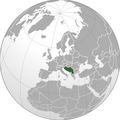
Australia–Yugoslavia relations were historical foreign relations between now split-up Socialist Federal Republic of Yugoslavia and Australia. Australia and Yugoslavia established formal diplomatic relations in 1966.[1] Two countries decided to establish embassies, initially at the Charge d'Affaires level, to facilitate practical contacts, particularly in the field of migration.[2] Australia recognized advantages of special relations and contacts with other countries in Eastern Europe but also the role it played in many of the meetings and activities of Non-Aligned countries.[2] Relations between two countries were complicated by Yugoslav bad relations with its emigration in Australia which was often perceived to be significantly prone towards radical nationalism, anti-Yugoslavism and even widespread sympathies for the World War II collaborationist movements. Delegation of the Parliament of Yugoslavia visited Australia in 1970, while the Parliament of Australia returned visit (led by William Aston) in February 1971.[3]
In 1988 a nationalist diaspora led anti-Yugoslav demonstration in front of the Yugoslav Consulate in Sydney resulted in security guard shooting and wounding Josef Tokic.[4] This led to diplomatic crisis in relations between the two countries when Australian side presented the consulate with a rejected ultimatum to surrender Zoran Matijaš, the security guard involved in the incident.[4] Two countries expelled a certain number of diplomats (including Zoran Matijaš who was welcomed in Belgrade as a hero) but avoided trade retaliation.[4]
Following the breakup of Yugoslavia and Yugoslav Wars judges Ninian Stephen, David Hunt and Kevin Parker from Australia served at the International Criminal Tribunal for the former Yugoslavia.[5] Australia also sent its armed forces to the United Nations Protection Force, Implementation Force and Stabilisation Force in Bosnia and Herzegovina.
YouTube Encyclopedic
-
1/5Views:883 5631 361 9709 166 9931 246 8782 906 683
-
BALKAN STEREOTYPES EXPLAINED - YUGOSLAVIA
-
Did you know in Serbia.....
-
Why Did So Many German Officers Flee to Argentina after WW2?
-
How Yugoslavia Practically Liberated Itself in WW2 | Animated History
-
Why Was Hungary Punished So Severely After World War One? (Short Animated Documentary)
Transcription
See also
- Yugoslavia and the Non-Aligned Movement
- Death and state funeral of Josip Broz Tito
- Australia–Croatia relations
- Australia–Kosovo relations
- Australia–North Macedonia relations
- Australia–Serbia relations
- Australia–Slovenia relations
- Yugoslavia at the 1956 Summer Olympics
- Australia at the 1984 Winter Olympics
References
- ^ "Serbia country brief". Department of Foreign Affairs and Trade. Retrieved 22 November 2020.
- ^ a b "AUSTRALIAN DIPLOMATIC RELATIONS WITH YUGOSLAVIA". Department of Foreign Affairs and Trade. Retrieved 22 November 2020.
- ^ Milutin Tomanović, ed. (1972). Hronika međunarodnih događaja 1971 [The Chronicle of International Events in 1971] (in Serbo-Croatian). Belgrade: Institute of International Politics and Economics. p. 2562.
- ^ a b c David Humphries (3 December 1988). "From the Archives, 1988: Australia expels Yugoslav envoys over shooting". The Sydney Morning Herald. Retrieved 22 November 2020.
- ^ "Former Judges". International Criminal Tribunal for the former Yugoslavia. Retrieved 22 November 2020.





